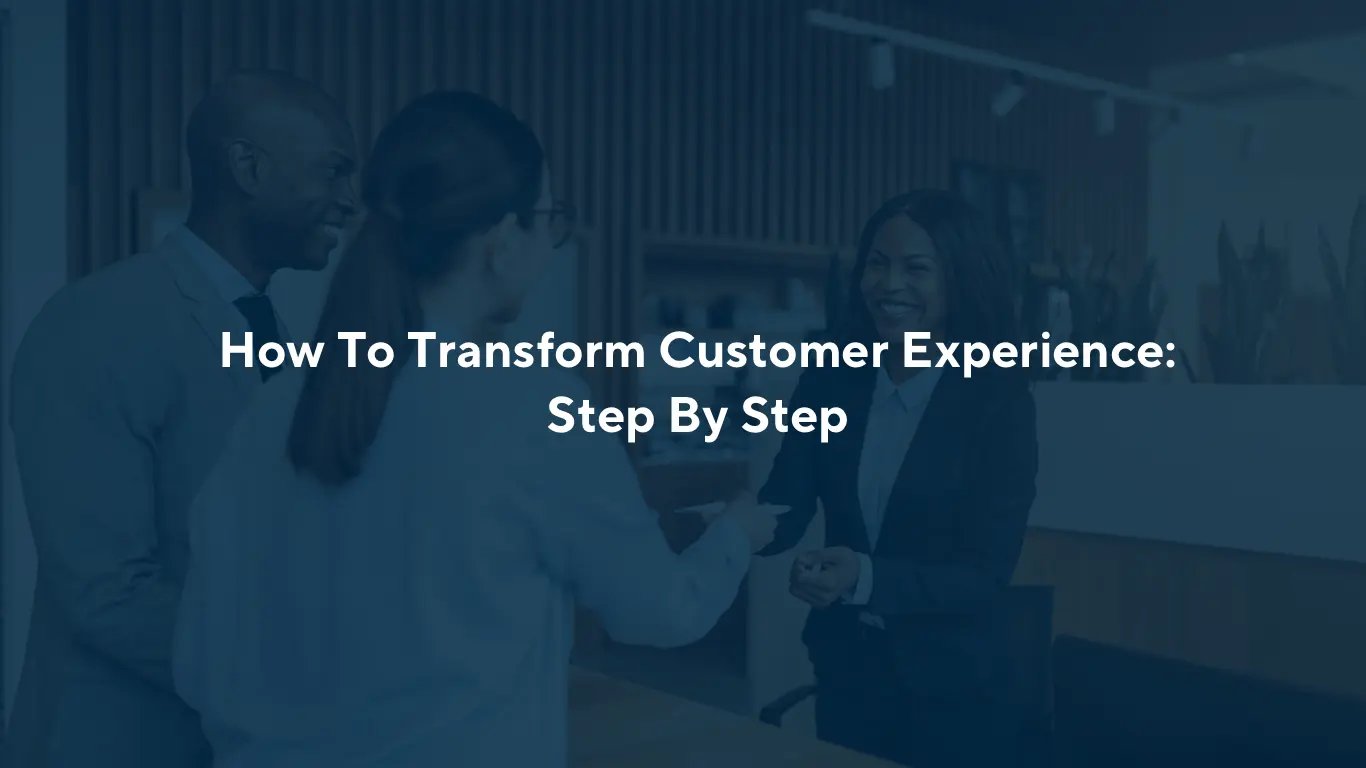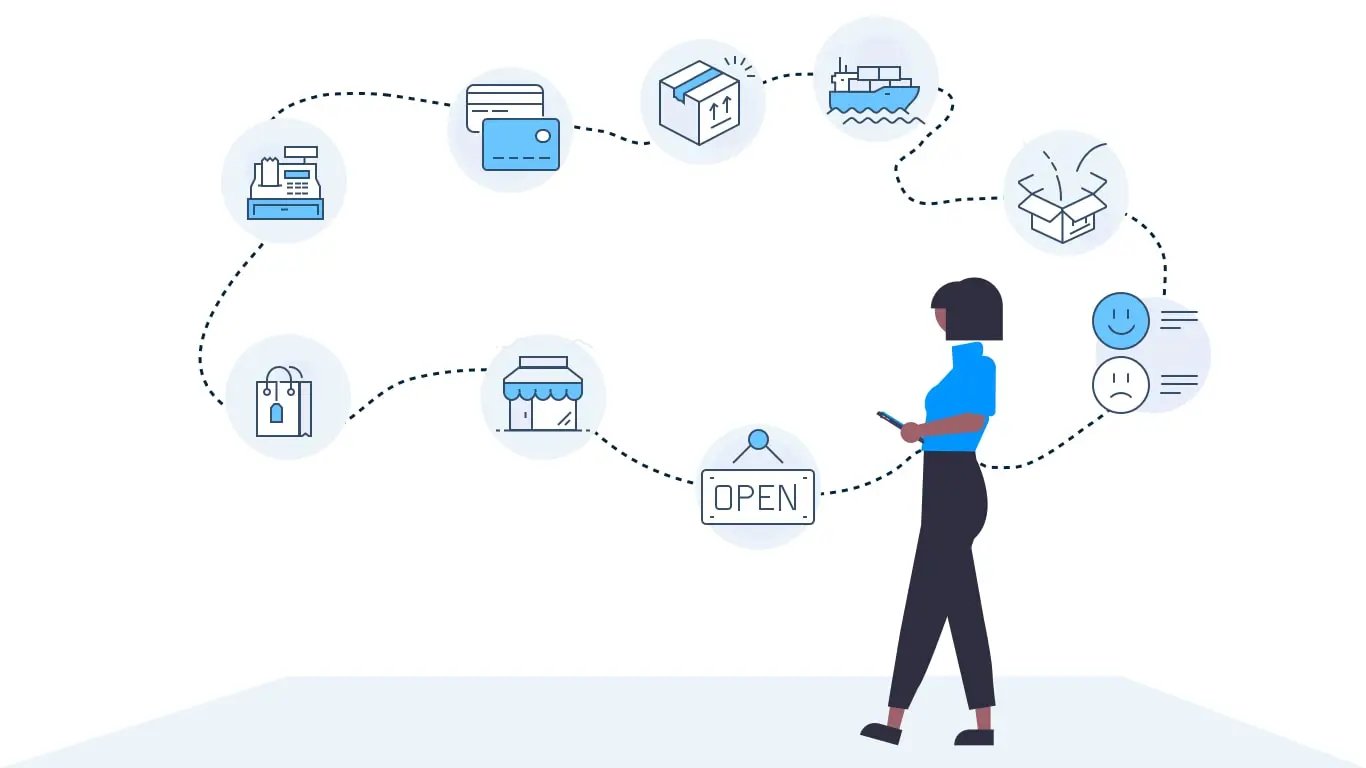
Companies across the globe are recognizing the importance of investing in customer experience. With greater customer retention, increased revenue, and profitability – it is a worthy strategic initiative.
However, planning and executing a customer experience transformation is a multi-layered process that can quickly become overwhelming.
Before you know it, you’ll need to know how to strategize, secure leadership buy-in, and navigate technology implementation. Knowing where to start isn’t always straightforward.
Here, we’ll provide a walkthrough of how to execute a CX transformation in your organization successfully.
Understanding Customer Experience Transformation
Customer Experience (CX) Transformation is a strategic approach that aligns people, streamlines processes, and implements technology to promote customer-centricity. CX transformations focus on creating outstanding experiences for your customers across every touchpoint along their journey with your business.
90% of businesses, no matter what industry they're in, are putting customer experience first. Why?
Because the benefits are undeniable. Here are some to start:
- Increased customer loyalty and retention
- Enhanced brand image
- Higher revenue and lower support costs
- Competitive Advantage
Learn More: Customer Experience Management: The Complete Guide
Customer Experience Transformation: A 5-Step Plan
From setting the foundation, implementing a CX transformation strategy, and setting in motion a plan to ensure ongoing success, the next section will break down customer experience transformation into 5 actionable steps.
STEP 1: Setting The Foundation for CX Transformation

The first step is to plan out your CX transformation. Identify what your current customer experience looks like and define what future success will look like.
1. Assess Your Current Customer Experience
To better assess and understand your customer experience, there are two steps:
-
Gather Customer Feedback and Data: Conduct customer surveys to understand what customers are experiencing. You can also mine feedback on social media and online reviews.
-
Identify Pain Points and Areas for Improvement: Review customer feedback data to identify common customer complaints or issues. Maybe you notice frequent mentions of slow response times or inconsistent service; keep a record of them.
Learn More: How To Collect Customer Feedback And Put It To Good Use
2. Establish Clear Goals and Objectives
When setting a goal for your CX transformation, establish a vision and get precise about what you want to achieve.
-
Define Specific Objectives: Be clear about your goals. An example of a specific objective could be "Increase customer retention by 15% in the next year.”
-
Align with broader business goals: Align your CX objectives with broader business goals such as revenue growth or market expansion.
-
Prioritize Key Metrics: Identify the key performance indicators (KPIs) to help you measure progress. Examples include customer satisfaction scores, retention rates, and average response times.
Related: Customer Lifetime Value: Why it Matters & How to Measure It
3. Secure Leadership Buy-In and Support
A successful CX transformation needs the support of your organization's leadership team. Make a compelling case for your initiative.
-
Present Findings To Leadership: Use the data you collected during the assessment phase. Highlight the potential impact of CX transformation, like reducing customer churn.
-
Clearly Define Roles and Responsibilities: Specify the roles and responsibilities of each team member involved in the transformation. Having a clear understanding of who is responsible can instill greater confidence.
-
Provide a Roadmap: Outline the steps and timeline for the transformation. Use this opportunity to discuss potential challenges and how you plan to mitigate them.
-
Demonstrate ROI: Show how a CX transformation can provide a return on investment and how it aligns with your organization's long-term vision and growth.
STEP 2: Designing a Winning Customer-Centric Strategy

Now that you’ve laid the foundation for your CX transformation, you are ready to start developing your strategy.
1. Conduct Customer Research and Analysis
Creating a customer-centric strategy requires a deep understanding of your customers. Here's how to achieve it:
-
Build a Customer Persona. Personas are detailed fictional representations of your ideal customers. Include details about demographics, behavioral, and psychographic traits. Understanding your customers’ needs, preferences, and pain points is crucial for tailoring everything from interactions to product development.
-
Identify Every Customer Touchpoint. Map out every touchpoint and interaction a customer has with your business. Touchpoints include website visits, social media engagement, phone calls, and in-store experiences.
2. Map the Customer Journey
The customer journey is a critical element of a customer-centric strategy. Here's how to create an effective map:
-
Identify Key Touchpoints: You’ve already mapped your customer touchpoints; however, some are more critical than others. These are the moments that influence how a customer perceives your brand. Identify these key points where customer opinions can be significantly swayed and focus on optimizing them.
For example here are some key touchpoints relevant to the healthcare industry:
-
Appointment scheduling: How easy is it to book appointments and how long are the wait times?
-
Patient interaction: What is the quality of care or level of communication and empathy shown by healthcare professionals?
-
Post-appointment follow up: Is there appropriate follow up care, reminders and after-care support?
-
Streamlining and Optimizing the Customer Journey: Once you've identified the key touchpoints, it’s time to refine. Eliminate unnecessary steps, reduce friction, and ensure each interaction is as efficient and pleasant as possible. Speed, convenience, knowledgeable help, and friendly service are considered the most important elements of a positive customer experience by nearly 80% of American consumers.
3. Foster a Customer-Centric Culture
Customer-centric culture puts customers at the center of all actions. It is a mindset that needs to be adopted across the organization.
-
Align Organizational Values with Customer-Centricity: Align your organization's values and mission with customer-centricity. Every decision, from product development to customer support, should aim to improve customer experience.
-
Empower Employees to Prioritize Customer Needs: Empower your front-line employees to make decisions that prioritize customer satisfaction with a level of autonomy. For instance, at Ritz Carlton, every employee has the freedom to use up to $2000 to solve resolve customer complaints how they sit fit.
Learn More: Customer Experience Management Strategy: How to Get Started
STEP 3: Implementing CX Initiatives That Delight

Now, it’s time to create real, tangible experiences for your customers. The following initiatives will help you create memorable experiences for your customers and foster stronger relationships.
1. Enhance Employee Training and Engagement:
Employees are at the forefront of customer interactions and engagement. Equip them with the appropriate training and promote customer-centricity by doing the following:
-
Equip Employees with CX Skills and Knowledge: Start by providing skills training. Teach employees how to empathize with customers, actively listen, and resolve issues effectively.
-
Give Recognition and Rewards: Implement a recognition and rewards system that acknowledges employees who consistently provide exceptional customer service. This can boost motivation and reinforce a customer-centric culture.
2. Implement Personalized Customer Interactions:
Today’s customers want personalized interactions that anticipate their needs and preferences.
-
Leverage Customer Data: Use your customer data to understand their preferences, purchase history, and pain points. You can use this information to offer more personalized interactions.
-
Utilizing Automation and AI: Embrace automation and artificial intelligence (AI) to scale your personalization efforts. These technologies can analyze vast amounts of data to deliver personalized recommendations, messages, and support in real-time.
3. Create Seamless Omnichannel Experiences
Today's customers expect companies to provide consistent service through their preferred channels. How to meet those demands:
-
Integrate Communication Channels: Integrate various customer interaction channels, such as in-store, online, mobile, and social media. An integrated approach ensures that no matter how customers reach out, their experiences remain consistent.
-
Ensure a Frictionless Switch Between Channels: Customers may transition between different channels for support. It’s essential to make this transition seamless. For instance, if a customer starts an inquiry on your website and then calls customer support, the agent should have all the relevant information available. An omnichannel contact center solution is one way to achieve this seamless interaction.
STEP 4: Leveraging Technology and Data For Effectiveness

Transforming customer experience is nearly impossible without leveraging the right technology.
1. Implement a Robust Customer Data Management System
Implementing a customer data management system involves collecting and analyzing customer data to gain profound insights into their preferences, behaviors, and interactions.
-
Collect and Analyze Customer Data: Implement strategies to capture data such as preferences, interaction frequency, or behavioral patterns. For a more accurate dataset, use various sources. Your interactions will be better personalized as a result.
-
Ensure Data Privacy and Security: Maintain stringent data privacy and security measures. Look for technology solutions that have robust security protocols, access controls, 2-factor authentication, and transparency. This way, you not only protect customers' sensitive information but also build trust, a cornerstone of long-term customer relationships.
2. Leverage AI and Machine Learning
60% of CX leaders expect AI to have a transformative or significant impact over the next two to five years. Here’s how to leverage some powerful AI-powered tools and glean deep insights for better CX:
-
Predictive Analytics: Predictive analytics uses data and machine learning to predict future events. Anticipating customer needs through predictive analytics allows you to provide proactive and timely support. For instance, it can help you offer exclusive discounts on items they are likely to be interested in.
-
Sentiment Analysis: Sentiment analysis identifies the tone or sentiment expressed through voice or text. Using this technology in a sales and support environment can help you gauge the emotional tone of interactions, allowing agents to tailor their approach and get better results.
3. Embracing Emerging Technologies
Embracing emerging technologies like chatbots, virtual assistants, and voice and visual interfaces pushes CX to the next level. Here are some to get started:
-
Chatbots and Virtual Assistants: Chatbots are tools for messaging apps that simulate human conversation. Use them to perform routine tasks like answering frequently asked questions and giving your customers instant support and information.
-
Voice and Visual Interfaces: Voice interfaces allow you to interact using spoken commands like Siri and Alexa. Visual interfaces, on the other hand, use images, graphics, and icons to facilitate user interaction. It’s similar to navigating through a website or app. A brand's voice and visual elements can be combined to create a more inclusive user experience, making communication and engagement more accessible.
Learn More: Customer Experience Platforms: 10 Types To Use In Your Business
STEP 5: Measuring and Improving CX For Continued Success

Now that you’ve developed your strategy and implemented your CX initiatives, it’s time to measure the success of your efforts.
1. Establish Key Performance Indicators (KPIs)
KPIs or key performance indicators are statistics that provide crucial insights into the health and performance of your CX efforts. Here are some important CX metrics to get you started:
-
Net Promoter Score (NPS): Net Promoter Score is a widely recognized KPI that gauges overall customer satisfaction and loyalty. It asks customers a simple question: "On a scale of 0 to 10, how likely are you to recommend our company to a friend or colleague?" This score helps measure the strength of your customer advocacy and identifies areas for improvement.
-
Customer Satisfaction Score (CSAT): This metric assesses customers' satisfaction with a specific interaction or transaction. It typically uses a rating scale or a direct question to gauge the customer's satisfaction with the experience. CSAT provides valuable insights into individual touchpoints.
Learn More: How To Measure Customer Experience: Tracking Key Metrics
2. Implement Regular Customer Feedback Loops
A feedback loop is like a continuous conversation between you and your customers. It involves systematically gathering and analyzing customer feedback through various methods, creating an ongoing dialogue that informs strategic decision-making. Here’s how you can implement it:
-
Regularly Conduct Surveys, Interviews, and Focus Groups: These feedback methods allow you to delve deeper into specific aspects of the customer experience and collect qualitative data on what's working and what needs improvement.
-
Social Listening and Sentiment Analysis: Monitor social media and online platforms frequently to listen to customer conversations. AI and sentiment analysis tools can help you identify trends and emotions associated with your brand so that you can make the necessary adjustments.
3. Continuously Adapt and Optimizing CX Initiatives
Customer preferences, technology, and trends constantly evolve, so staying up-to-date is crucial. Here’s how:
-
Analyze Customer Feedback: Identify recurring themes or customer pain points and act on the feedback. Use this data to inform strategic decisions and prioritize areas that require enhancement, like a complicated check-out process.
-
Experiment and A/B Test: Continuous improvement requires experimentation. Test different approaches, messages, or processes to understand which ones lead to the best customer outcomes.
Overcoming Challenges in CX Transformation

While the journey toward Customer Experience (CX) Transformation is essential, it is not without its challenges. Addressing these common obstacles head-on is crucial for a successful transformation.
1. Address Organizational Resistance to Change
With employees becoming accustomed to existing processes, there is often a natural desire to maintain the status quo. Change can be difficult, so here are some ways to navigate resistance to your CX transformation:
-
Communicate Value and Benefits: Start with clear communication. Highlight the ways in which it can improve their roles, including clearer direction and better communication. Articulate the value and benefits of CX transformation and how it aligns with the goals and success of the organization and can.
-
Engage Stakeholders in the Process: Ensure leadership teams and key employees actively engage in the transformation process. Their involvement makes them advocates for the changes brought about by CX transformation.
2. Secure Necessary Resources and Budget
Competing priorities, budget constraints, and limited awareness can make it difficult to secure the resources needed for your CX transformation difficult. Here’s how you can navigate this challenge:
-
Demonstrate the ROI of CX Investments: Securing resources and budget hinges on demonstrating the return on investment (ROI) of CX initiatives. Present data-driven insights showcasing how the transformation contributes to increased customer satisfaction, loyalty, and, ultimately, revenue.
-
Seek Out Cost-Effective Solutions and Partnerships: Explore cost-effective solutions and strategic partnerships to optimize resource allocation. Collaboration with external partners can bring expertise and technologies without straining the budget.
3. Adapt to Evolving Customer Expectations and Trends
Customer preferences and industry trends are dynamic and ever-changing. They require you to stay vigilant and make proactive adjustments. Here’s how:
-
Stay Informed About Industry Shifts and Innovations: Regularly assess market trends and competitor strategies to adapt your CX initiatives accordingly.
-
Anticipate and Adapt to Changing Customer Needs: Anticipate and adapt to changing customer needs by fostering a culture of continuous improvement. Actively seek customer feedback, conduct regular market research, and remain agile in adjusting strategies based on evolving expectations.
Final Thoughts: The Ongoing Nature of CX Transformation
A CX transformation is not a one-time endeavor. It is an ongoing process of refinement and adaptation. Customer expectations evolve, and your organization needs the mindset and flexibility to change with them.
The strategies outlined here provide the roadmap to navigating the complexities of a CX transformation. These best practices, including the right technology, can help you cultivate a customer-centric culture that not only meets but exceeds customer expectations.







